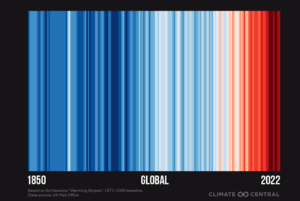Climate Change: The Science Behind It All
R. David Williams—Geologist

Climate science traces its origins back to the discovery of the earth’s “greenhouse effect” by French mathematician and physicist Jean Baptiste Joseph Fourier in 1824. Fourier had made some fundamental calculations of what the temperature of a body in space should be given its distance from the sun and determined that the earth was approximately 50 degrees warmer than he expected, due, he thought to “non-luminous heat” being unable to pass back through the atmosphere. The science and the scientific instruments of the 1820s were not sufficiently advanced to detect this “non-luminous heat” as the infrared radiation we now know it to be. In 1872, John Tyndall, an English physicist and mountaineer, conducted experiments and identified water vapor and CO2 as the principal “greenhouse” gasses (GHG), even though similar experiments had been done by Eunice Foote, an American scientist in 1856. Swedish chemist Svante Arrhenius, in 1896, was the first to suggest that the continued addition of CO2 into the atmosphere through the burning of fossil fuels would raise the temperatures in the lower atmosphere. This was not viewed as a problem at the time for several reasons: Industrial CO2 emissions in the late nineteenth century were a fraction of later emissions and the oceans were thought to be capable of absorbing most of the emissions.
In the early twentieth century, scientific disagreements about the role of CO2 and two world wars led to a hiatus during which there was little scientific progress on the role CO2 might play in changing the climate. After the Second World War, a new generation of scientists including English engineer Guy Callendar, American Scientists Charles Keeling, Roger Revelle and Hans Seuss and Canadian physicist Gilbert Plass made huge strides in understanding and presenting detailed information about the role of CO2 in changing the earth’s climate.
This was followed in 1967 by the first comprehensive computer model of the earth’s climate, developed by Japanese and American climatologists Syukoro Manabe and Richard Weatherald. This model, though primitive compared with more current climate models, reinforced predictions of a warming climate with increased atmospheric CO2 and even predicted many of the current observations in a changing climate.
This increased understanding of the role CO2 plays in the earth’s climate led to the formation of the Intergovernmental Panel on Climate Change (IPCC) in 1988. The IPCC reports, through the Sixth Assessment Report released in 2022, have continued to refine the science and inform policy makers.
The various components of the climate system include phenomena that humans have no control over: orbital changes, incoming solar radiation, volcanic and tectonic activity, natural changes in variability like El Nino and La Nina, snow/ice cover, cloud development, and localized factors like wildfires. The system also includes components over which people do have some control: land and water use, particulate air pollution, and the composition of the
atmosphere. Changes in the composition of the atmosphere through the addition of GHGs to the atmosphere change the amount of energy radiated back into space, warming temperatures in the lower atmosphere as scientists first postulated over 100 years ago.
While the fact that the climate may have been warmer or colder in the past is certainly of interest to geologists, paleontologists and biologists among others, it is essentially irrelevant to continued accumulation of heat in the earth’s oceans and lower atmosphere now. This is due to the fundamental physics of carbon dioxide and other greenhouse gases and their ability to absorb infrared radiation, which have been understood for over 140 years as discussed above. We know through measurement, basic math and isotope geochemistry that we are adding carbon dioxide to the atmosphere. It is also a scientific fact that a warmer atmosphere contains more water vapor, which as John Tyndall discovered, is also a greenhouse gas which further contributes to both warming and more intense rainfall events. Temperatures continue to rise and are reflected in the fact that the warmest eight years have all been since 2015, with 2016, 2019 and 2020 constituting the top three. An exceptionally strong El Niño event occurred in 2016, which contributed to record global temperatures. The current global heat wave only reinforces the science!
This matters because we depend on reliable weather and precipitation to support our modern industrialized society of over 7 billion people. A changing climate threatens our ability to plant and harvest agricultural crops, harvest fisheries, and support the infrastructure that underlies our complex industrial society.
Failure to take action to address this complex environmental problem leaves fundamental physics in charge. It will not end well.

